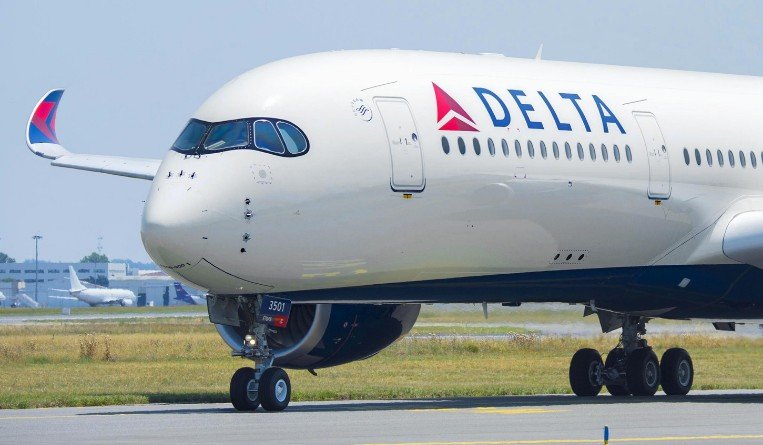When the pandemic struck, of the large players, Delta Air Lines was arguably the carrier that made the deepest cuts. It slashed its fleet by 200 aircraft, accelerated the retirement of its Boeing 767 fleet and sold its entire contingent of Boeing 777s – the widebody type that many competitors have favoured for their cargo flights.
Delta is replacing the 777s and 767s with Airbus A350s and A330s, which provide better cargo capability, noted Robert Walpole, vice president cargo, who took over the reins last December.
The airline has 10 A350s in service and orders for another 20 in the pipeline. In July it signed a lease agreement for an additional seven A350s, which will start joining its lineup early next year.
Unlike United or Air Canada, Delta was slow to mount cargo flights with its passenger widebody planes, but this rapidly gathered momentum once it got under way, although many are not formally classified as cargo flights. Walpole described the approach to international widebody flights as a “cargo-led strategy,” where freight is the primary revenue generator and passenger revenues top up the income. Routes to Rome, Milan or Nagoya are examples of this strategy.
Financial results reflect this development. In the first quarter cargo revenues reached US$215 million, a rise of 12% from a 2019 baseline. In the second quarter they climbed to US$251 million, up 35%. Overall, the airline posted a pre-tax loss of US$880 million for the second quarter.
According to Walpole, the role of the cargo division as the prime revenue earner has elevated its influence on strategic decisions, such as network design.
Under his leadership the cargo division has undergone some organizational restructure and is driving digitization, where full deployment of APIs with key logistics clients is a big priority on the customer-facing side. Delta Cargo is reengineering its booking platform, following the implementation of new pricing capabilities late last year to make the process more user-friendly.
Operationally much focus has gone on the refinement of the carrier’s cold chain capabilities.
“We matured our service offering to the pharmaceutical and temperature-controlled market. We built a very good product and service to support vaccine distribution through our control tower here with an expanded capability for our customers and we leverage that more broadly now across our pharmaceutical and temperature-controlled network,” said Walpole. He added that Delta is in the process of upgrading its capabilities in San Juan, Puerto Rico, and New York’s JFK airport.
E-commerce is another area where he sees large potential. One segment of interest is the OEM sector – auto manufacturers, spare parts providers and repair centres looking for distribution capabilities that can leverage same-day or overnight delivery.
“We have shorter lead times than the parcel carriers,” Walpole said.
This requires first- and last-mile capabilities. To some extent, Delta can cover this through its partnership with Roadie, which can reach 89% of the US with same-day service, but Delta is looking to recruit additional support on that front.
The second major focus is to leverage Delta’s domestic Dash network to serve e-commerce clients that look for time-definite shipping to residential addresses. The company is in the process of implementing some changes with the Dash service which will facilitate this, Walpole said. He added that the partnership with Roadie is core in this segment.
Delta is also making some changes in the warehouse. At the major hubs it wants to compartmentalize part of the facilities to operate like a unit-level warehouse in order to reduce lead times and the time frames for the preparation of orders; in certain markets it wants to expand the drop-off facilities for Dash customers.
Over the past months, Delta has ramped up its network and schedule again. According to airline CEO Ed Bastian, US domestic leisure travel has returned to pre-pandemic levels. The rebuilding of international operations is taking longer, given travel restrictions in many countries.
Between its home market and Europe, Delta has recovered over 50% of its network, but many sectors are still very congested, Walpole said.
He noted that Europe is further down the path to recovery than Asia, and he does not expect a dramatic resurgence in the latter market for the near future.
“I don’t see a significant uptick with Asia for the rest of the year,” he said. “We continue to run operations into our primary markets in Asia, which are Japan- and Korea-centric for us right now, predominantly on the back of the cargo business.”
Delta has the benefit of the SkyTeam joint venture for broader capacity and routes serving international markets. This has benefited from the airline’s deployment of more widebody aircraft on US domestic routes, which provide more options for connections.
As for the joint venture itself, which is mature, Walpole does not expect to see any significant changes ahead, but there is room to make adjustments, for instance improving connectivity to and from Latin America by making some changes in Atlanta, he said.
Looking to the market, Walpole and his team wants to engage more with customers to see how Delta can best position its capacity to link with customer requirements and doing this in a more proactive, future-looking way.
“A lot of our customers are looking for that and are asking for that, because capacity availability and supply-demand balance in this industry right now is very skewed and will remain so for the next period – one year plus probably,” he said.
Ian Putzger



